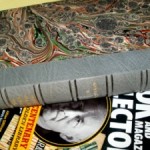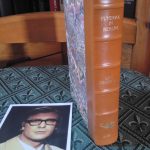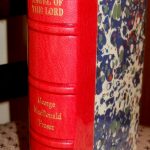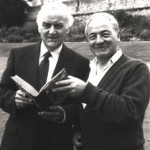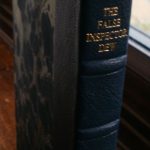The Collectibilty of Leather Rebinds
In Centuries past libraries in great houses were lined with leather bound volumes. They provided accessibility to knowledge, exuded learning and gave satisfaction to the owner – who had given time and effort in assembling his or her collection. The subject matter was often legal texts and histories – explaining inheritance of land and titles; and perhaps changes to the estate, the buildings and gardens. The books were important to the owners as they signified who they were. As time went on the books would need restoration and in due course rebinding. These treasures must be carefully preserved.
By the time of the 20th Century with its great social change and the vast increase in literacy the population read magazines, newspapers and books as never before. Many of the youngsters were introduced to children’s literature; later to comic stories of adventure, even science fiction and macabre tales of horror. Publishers fed a ready market with uniform or cheap editions as the original hard cover would have been expensive. Avid readers sought out the best writers – those who had a reputation, whether in mainstream (an increasingly elastic term) or genre fiction. And with affluence a market for the best books grew. Some collected the writers they have loved over the years. A nice first edition of a highlight was the thing – if it was signed by the author even better.
One of the problems about collecting first editions of the highlights of 20th Century literature is that hardly any copies surface; fine copies in a reasonable jacket of say Graham Greene’s Brighton Rock will cost a fortune. Even with no jacket one will have to pay perhaps ten times the cost of a new hardback. Even tidy copies are hard to find, and no one wants a first that has seen better days. So in practice many books cannot be found. This is why a few select booksellers began to rebind first editions to give them a new lease of life. The cost of rebinding by skilled craft binders selecting the materials and doing some restoration means that only the most desirable books are rebound.
In 2018 Scorpion Press started undertaking rebindings of mystery books. Typically, the books selected were the first novel or early in an author’s career when the print run would have been fairly low. Authors such as Lindsey Davis, Peter Lovesey, Tana French and Minette Walters. Each book was produced in a run of twelve lettered copies signed by the author with a new introduction. The books have gilt titles and raised bands and scorpion logo to the spine; unlike other leather rebindings, the Scorpion Press has continued with its trademark of marbled papers sides. These are specially made and colour co-ordinated.
In 2020 Scorpion Press expanded the area of interest to books that had been adapted to the big screen. The introduction gave consideration not only to the distinctive merits of the book but the film as well. This was reinforced with a film still. The collectable value or pull to the collector was increased still further with the inclusion of the autograph of the film star. Michael Caine agreed to sign Len Deighton’s Funeral in Berlin (1964) and Jack Higgins war classic The Eagle has Landed (1975). If one is a fan of Deighton or Higgins this is simply a “must have”. Why? First editions on the open market for landmark books signed by the author and star are priced at astronomic levels because they have a following of people who can afford to pay for that rare thing. Naturally, after nearly fifty or sixty years since these books were issued and the authors long retired, it is indeed a rarity.




